
.jpg?crc=3971554231)
John Wesley, Untitled 1979
acrylic on paper, 15 x 21 in.
photograph courtesy of the artist and Fredericks & Freiser, NY
Line and Verse @ Andréhn-Schiptjenko
“Line and Verse” at Gallery Andrén-Schiptjeko, Stockholm, Sweden, was a rare kind of exhibition. Although it was in a commercial gallery, the show here featured a crowd of whom it does not represent even one—an all American crowd at that. The other rare thing is that the curator is an artist. Ridley Howard, also American, who splits his time between Athens, GA and Brooklyn, NY.
It’s refreshing from the start, entering the gallery space and meeting Brian Kalvin’s pop art influenced “Soft Focus”, from 2017. Out side the gallery lies the snow in big piles and it’s freezing, but Soft Focus seems drenched in the artist's native California sun. I am now inclined to see the gallery as a warm respite.
In the main space I am hit by John Wesley’s beautiful acrylic wave painting, “Untitled”, from 1979. Nothing about it betrays the fact that it is the oldest painting here. At first glance it looks more like a print than a painting, with perfectly blended colors and highly stylized lines that make me think of Japanese woodcuts and French cartoons like Tintin. Wesley is an artist from the pop art generation but has also been classified under the wing of the minimalist movement, (mainly because Donald Judd had a high regard for Wesley’s
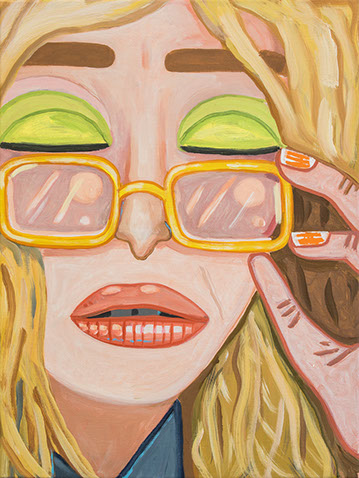
Brian Kalvin, Soft Focus, 2017
Acrylic on linen, 24 x 18 in.
Courtesy the artist and Anton Kern Gallery, New York
work) . In this very painting I can see both tendencies, the strictness of the color scheme and line, and the timeless motive of an horizon with a cartoonist language.
Next to Wesley’s piece hangs a work by the curator himself —Ridley Howard’s
Dream Painting, Orange and Silver from 2018. The paintings surface is split in two, sleeping girl pictured on the top part and a snowy mountain rage on the bottom. The girl seems to sleep in a warm orange-lit space, but she is dreaming of a cold place. Is it the winter in Stockholm she is dreaming of? Is Howard the dreamer? Or is he dreaming of the girl that dreams of mountains? The painting doesn’t distinctly answer, but it´s engaging to view. It’s small and intimate, and even though the two images are divided by sharp red edges, it’s peaceful and still.
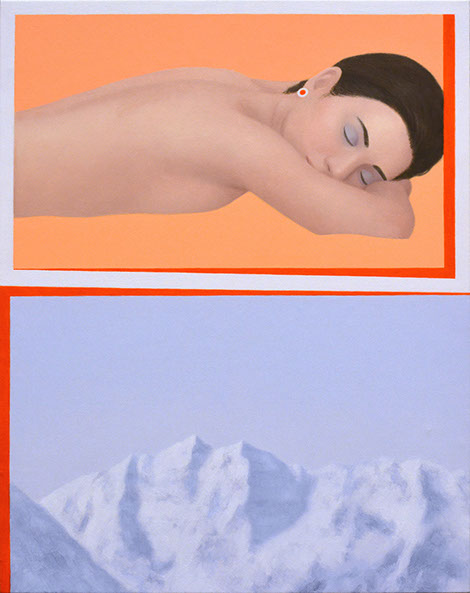
Ridley Howard, Dream Painting, Orange and Silver, 2018
oil on linen, 14 x 11 in.
photograph courtesy of Courtesy of the artist and Andréhn-Schiptjenko, Stockholm
Howard’s painting has a visual similarity with Eleanor Ray’s painting Marfa Window III, a small realistic painting with a strong presence of it’s own. It’s picturing a dark interior with a big window. The light in the landscape outside seems almost blindingly light. There are shapes of threes and a mountain in the horizon, almost like a dessert landscape. Also, this panting is very still, like an empathy waiting room in the middle of nowhere.
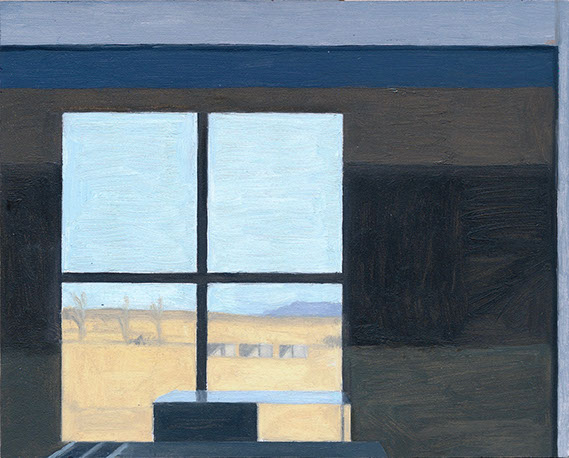
Eleanor Ray, Marfa Window III, 2017
oil on panel, 6 1/2 x 8 in.
photograph courtesy of Eleanor Ray
Apart from the more realistic or pop-influenced works, there are some interesting abstract works presented among the sixteen paintings in the show. Noteworthy is Lui Shtini’s Helle from 2017, is a beautiful symmetric shape on top of a dark red background. Mitchell Wright’s fifteen black holes, also from 2017, is a striking Op Art piece with a minimalistic approach.
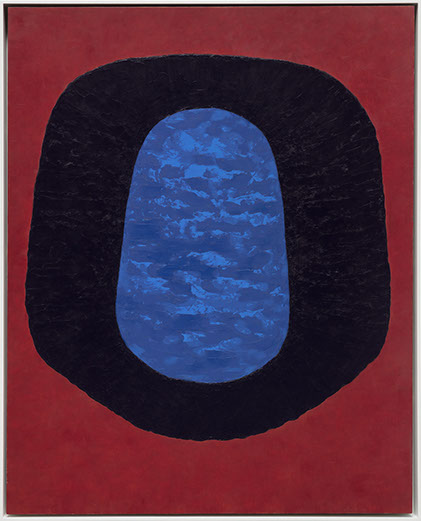
Lui Shtini, Helle, 2017
Oil on board 20 3/8 x 16 1/2 in.
photograph courtesy of Courtesy of the artist, Kate Werble Gallery, New York and Andréhn-
Schiptjenko, Stockholm
For me, Loie Hollowell’s Stacked Lingam (blue, orange, flesh), November 24, from 2017 is a standout. It’s an abstract symmetric shape, made with soft pastel on paper, simultaneously reminiscent of 60s Op art painting and turn-of last-century spiritualist Hilma af Klimt. It is beautiful in it’s rhythmic composition with soft sensual shapes in different kinds of blues. In the center, an oval, pointy shape is placed, seemingly in the core of what I rather perceive as waves (more so than a Lingam, which is the ancient Indian symbol for the phallus.) In context, one could naturally associate the yellow glowing oval as the female counterpart, Yoni, and therefore read the painting as a depiction of the two sexes in harmony. Regardless, this is a painting I feel I could spend a long time with, contemplating its shapes, its motion and depth.
Hollowell has left a white border around image, where she has taken notes: the date the painting is made, the color choices, her name, and the title of the piece. Some notes are also crossed out. These border notes give the painting a diary-like feeling and places it in time, namely the 24th of November, 2017. For me, the timestamp adds a nostalgic dimension to the work and makes me revisit that particular time.
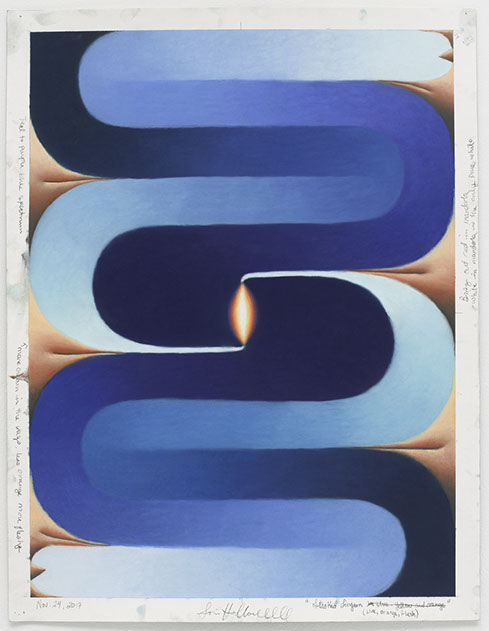
Loie Hollowell, Stacked Lingam (blue, orange, flesh), November 24, 2017
Soft pastel on paper, 32 11/16 x 26 5/16 in.
Image credits: © Loie Hollowell, courtesy Pace Gallery
Photo: Kerry Ryan McFate
Many of the other paintings in the show borrow elements from modernist masters. Louis Fratino’s Terracotta figure, 2017, is strikingly Picasso-inspired and Veronika Pausova’s Dividers, 2017 makes me think of the work of Max Ernst. One of my favorite pieces is Alan Prazniak’s Matisse-influenced piece, Born Enchanter from 2017. The small painting describes a night landscape in blues, purple, and pale moonlight-green. Something I interpret as a mountain landscape with a lake and a path occupies the center of the painting. Several suns and moons seems to be glowing, in red and in yellow, some reflected in the lake. The painting is small, unlike Matisse’s paintings, just 16 x 20 in., but it holds a concentrated magic. This is for all the people with romantic hearts.
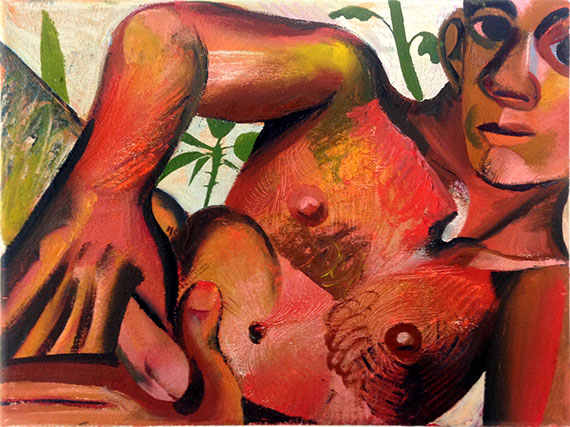
Louis Fratino, Terracotta figure, 2017
Oil and crayon on canvas, 9 x 12 in.
photograph courtesy of the artist and Antoine Levi, Paris
The show is visually diverse in terms of each artist’s style, technique and subject matter. It’s a show that easily could have been all over the place, yet it is held together by something much more subtle than a theme or a certain generation. I would call it the very love and care for the practice of painting itself, which exemplifies what he loves most about each artist. How Howard picked out these pieces seems highly personal, as if each and every artist is his dear friend, and every selected painting is emblematic of the relationship. It makes the show warm and friendly, like a mix tape you got from a dear friend. Some songs are sad and some are silly but they are all equally important, since every single one is chosen with care.
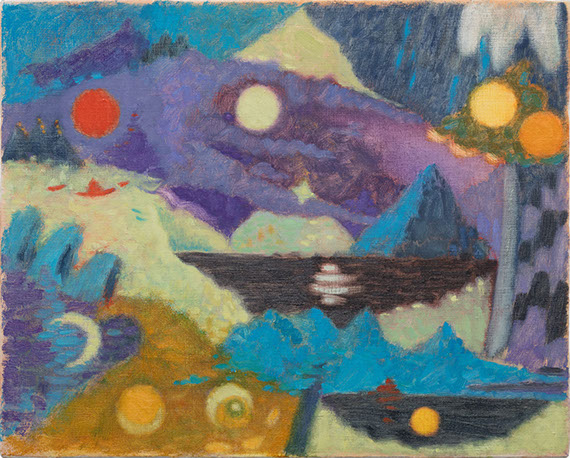
Alan Prazniak, Born Enchanter, 2017
Oil on linen, 16 x 20 in.
photograph courtesy of the artist and Andréhn-Schiptjenko, Stockholm
Line and Verse
Jan 11, 2018 - Feb 17, 2018
Andréhn-Schiptjeko
Hudiksvallsgatan 8, SE-113 30
Stockholm, Sweden
Tel: +46 8 612 0075
email: info@andrehn-schiptjenko.com
Disclaimer: All views and opinions expressed are those of the authors and do not necessarily reflect the views of the editors, owner, advertisers, other writers or anyone else associated with PAINTING IS DEAD.
